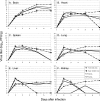Structural and nonstructural protein genome regions of eastern equine encephalitis virus are determinants of interferon sensitivity and murine virulence
- PMID: 18353963
- PMCID: PMC2346730
- DOI: 10.1128/JVI.02514-07
Structural and nonstructural protein genome regions of eastern equine encephalitis virus are determinants of interferon sensitivity and murine virulence
Abstract
Eastern equine encephalitis virus (EEEV) causes sporadic epidemics of human and equine disease in North America, but South American strains have seldom been associated with human neurologic disease or mortality, despite serological evidence of infection. In mice, most North American and South American strains of EEEV produce neurologic disease that resembles that associated with human and equine infections. We identified a South American strain that is unable to replicate efficiently in the brain or cause fatal disease in mice yet produces 10-fold higher viremia than virulent EEEV strains. The avirulent South American strain was also sensitive to human interferon (IFN)-alpha, -beta, and -gamma, like most South American strains, in contrast to North American strains that were highly resistant. To identify genes associated with IFN sensitivity and virulence, infectious cDNA clones of a virulent North American strain and the avirulent South American strain were constructed. Two reciprocal chimeric viruses containing swapped structural and nonstructural protein gene regions of the North American and South American strains were also constructed and found to replicate efficiently in vitro. Both chimeras produced fatal disease in mice, similar to that caused by the virulent North American strain. Both chimeric viruses also exhibited intermediate sensitivity to human IFN-alpha, -beta, and -gamma compared to that of the North American and South American strains. Virulence 50% lethal dose assays and serial sacrifice experiments further demonstrated that both structural and nonstructural proteins are important contributors to neurovirulence and viral tissue tropism. Together, the results of this study emphasize the complex and important influences of structural and nonstructural protein gene regions on EEEV virulence.
Figures






References
-
- Aguilar, P. V., R. M. Robich, M. J. Turell, M. L. O'Guinn, T. A. Klein, A. Huaman, C. Guevara, Z. Rios, R. B. Tesh, D. M. Watts, J. Olson, and S. C. Weaver. 2007. Endemic Eastern equine encephalitis in the Amazon region of Peru. Am. J. Trop. Med. Hyg. 76293-298. - PubMed
-
- Anishchenko, M., S. Paessler, I. P. Greene, P. V. Aguilar, A. S. Carrara, and S. C. Weaver. 2004. Generation and characterization of closely related epizootic and enzootic infectious cDNA clones for studying interferon sensitivity and emergence mechanisms of Venezuelan equine encephalitis virus. J. Virol. 781-8. - PMC - PubMed
-
- Bear, J. S., A. P. Byrnes, and D. E. Griffin. 2006. Heparin-binding and patterns of virulence for two recombinant strains of Sindbis virus. Virology 347183-190. - PubMed
Publication types
MeSH terms
Substances
Grants and funding
LinkOut - more resources
Full Text Sources
Other Literature Sources

